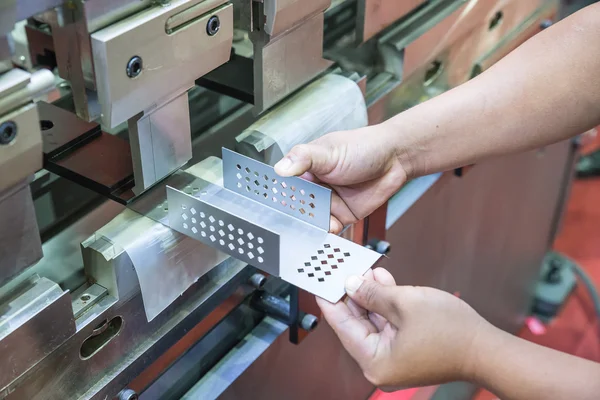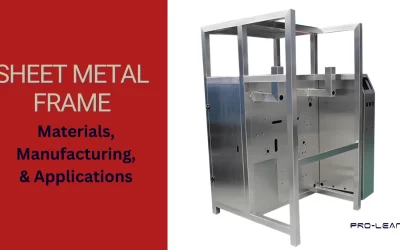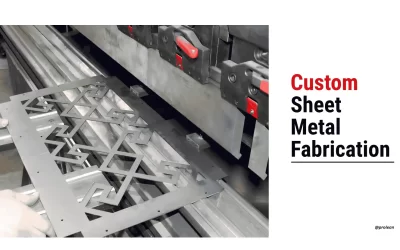
In the world of electrical engineering and manufacturing, the fabrication of electrical enclosures plays a critical role in protecting sensitive electrical components and ensuring the safe operation of electrical systems. These enclosures provide a secure housing that shields the components from environmental factors, prevents accidental contact, and offers ease of maintenance.
This case study examines the use of sheet metal punching in electrical enclosure manufacturing. We will cover the benefits, processes, and important considerations of this technique. Through a real-life case study, we will highlight the benefits of leveraging this method for electrical enclosure fabrication.
Understanding Electrical Enclosures
Electrical enclosures are specialized housings that protect electrical components, wiring, and circuits from various external factors. These enclosures are designed to ensure the safety and functionality of electrical systems in diverse applications. Understanding the key aspects of electrical enclosures is crucial for efficient fabrication processes.

Sheet metal punching operation
Electrical enclosures serve the purpose of housing and protecting electrical components and wiring systems from:
- Dust, dirt, and debris
- Moisture and water
- Physical damage and impact
- Electrical shocks and hazards
- The importance of electrical enclosures lies in:
- Ensuring the safety of individuals and property by preventing electrical accidents and fires
- Extending the lifespan and performance of electrical systems
- Facilitating proper maintenance and organization of electrical components
Types of Electrical Enclosures
There are various types of electrical enclosures available, each designed to meet specific requirements based on the application and environmental conditions. The following are the common types of electrical enclosures;
| Types of Electrical Enclosures | Description |
|---|---|
| Wall-Mounted Enclosures | Mounted directly on walls and typically used for small to medium-sized applications. |
| Floor-Mounted Enclosures | Larger in size and installed on the floor. Suitable for housing complex electrical systems and equipment. |
| Free-Standing Enclosures | Self-supporting and can be placed anywhere in a facility. Offers flexibility and easy access for maintenance. |
| Junction Boxes | Used for housing electrical connections and providing a secure enclosure for wire splicing. |
| Control Panels | Houses control devices, switches, indicators, and other components for monitoring and controlling electrical systems. Control panels are used in a variety of applications, including industrial, commercial, and residential settings. |
Key Considerations in Electrical Enclosure Design
When designing electrical enclosures, several factors need to be considered to ensure optimal functionality and safety:
| Key Considerations in Electrical Enclosure Design | Description |
|---|---|
| Material Selection | Enclosure materials should have adequate strength, durability, and corrosion resistance. Common materials include stainless steel, aluminum, and galvanized steel. |
| Environmental Conditions | Enclosures must be designed to withstand the specific environmental conditions of the installation site, such as temperature, humidity, and exposure to chemicals or corrosive elements. |
| Size and Space Requirements | Enclosure dimensions should accommodate the size and quantity of electrical components, allowing for proper installation, maintenance, and future expansions. |
| Protection Rating | Enclosures are assigned specific protection ratings (IP codes) to indicate their resistance to dust, water, and other environmental elements. |
| Thermal Management | Consideration should be given to proper ventilation, cooling systems, and heat dissipation to prevent overheating of components. |
Advantages of Sheet Metal Punching for Electrical Enclosure Fabrication
Sheet metal punching is a versatile manufacturing process that lends itself well to the fabrication of electrical enclosures. This technique involves using specialized machines to create precise holes, shapes, and features in sheet metal with high accuracy and efficiency. Sheet metal punching offers numerous advantages, including:
- Accuracy and Precision: Sheet metal punching ensures precise hole placement and shape replication, allowing for consistent and accurate fabrication of enclosure components.
- Efficiency and Speed: With advanced CNC machinery, sheet metal punching enables high-speed production, resulting in shorter lead times and increased productivity.
- Customization: Sheet metal punching allows for the creation of specific hole patterns, openings, and features to accommodate unique electrical component layouts and wiring configurations.
- Cost-Effectiveness: The efficient use of materials, minimal waste, and streamlined production process make sheet metal punching a cost-effective option for electrical enclosure fabrication.
- Design Flexibility: Sheet metal punching enables the fabrication of complex shapes, curves, and contours, offering design flexibility for enclosure customization.
- Versatility: Sheet metal punching can be applied to a variety of sheet metal materials, such as stainless steel, aluminum, and galvanized steel, catering to diverse application requirements.
Sheet Metal Punching Process for Electrical Enclosures
The sheet metal punching process for electrical enclosure fabrication involves several steps from material selections to additional fabrication processing. Let’s discuss each of them in brief.
| Stage | Description |
|---|---|
| Material Selection | Choose the appropriate sheet metal material based on the specific requirements of the electrical enclosure, considering factors such as strength, corrosion resistance, and cost. |
| Design and Engineering | Prepare detailed enclosure designs, taking into account the size, shape, hole patterns, and features required to accommodate the electrical components and wiring. |
| Tooling and Setup | Select suitable punching tools, dies, and fixtures based on the design specifications. Set up the punching machine with the appropriate tooling for the desired hole patterns and shapes. |
| Sheet Metal Preparation | Ensure the sheet metal is properly cleaned and deburred to eliminate any contaminants or sharp edges that may affect the punching process. |
| Punching Operation | Place the sheet metal onto the punching machine’s work table and align it according to the design specifications. Activate the machine to perform the punching operation, creating the desired holes, openings, and features. |
| Quality Control and Inspection | Inspect the punched sheet metal for accuracy, hole quality, and overall conformity to the design. Check for any defects, such as burrs or distortions, and make any necessary adjustments or corrections. |
| Additional Fabrication Processes | Depending on the specific requirements of the enclosure, additional fabrication processes such as bending, welding, and finishing may be carried out to complete the enclosure assembly. |
Case Study: Sheet Metal Punching in the Manufacturing of Electrical Enclosures
In this case study, we will explore a real-life example of how sheet metal punching was leveraged in the manufacturing of electrical enclosures for a telecommunications equipment provider. The company required custom enclosures to house their networking devices and equipment. Let’s dive into the details:
Customer Requirements and Challenges
The telecommunications equipment provider had specific requirements for their electrical enclosures:
- Customized Designs: The enclosures needed to be designed and fabricated according to the company’s specifications, incorporating specific hole patterns, openings, and cable entry points.
- Precision and Accuracy: The enclosure dimensions, hole sizes, and positions had to be precise to ensure compatibility with their networking devices and equipment.
- Efficient Production: With a high demand for their products, the company needed an efficient production process to meet their customers’ timelines and maintain a competitive edge.
Solution: Sheet Metal Punching for Custom Electrical Enclosures
To address the customer’s requirements, the manufacturer employed sheet metal punching as the primary fabrication method. The following steps were taken to ensure successful enclosure production:
- Collaborative Design Process: The manufacturer collaborated closely with the customer’s engineering team to understand the enclosure requirements and design specifications. This collaboration ensured that the enclosure designs aligned perfectly with the networking devices and equipment.
- Advanced CNC Machinery: The manufacturer utilized advanced CNC punching machines equipped with specialized tooling to achieve precise hole placement, shape replication, and feature creation. The use of CNC technology allowed for high-speed punching operations, meeting the customer’s production demands.
- Quality Control Measures: Stringent quality control measures were implemented throughout the production process. Inspections were conducted to verify the accuracy of hole placement, check for any defects or distortions, and ensure the overall conformity of the enclosures to the design specifications.
- Efficient Production Workflow: The manufacturer optimized their production workflow, streamlining the sheet metal punching process to achieve maximum efficiency. This included efficient material handling, tooling setup, and coordination between various production stages.
Results and Benefits
The application of sheet metal punching in the manufacturing of electrical enclosures for the telecommunications equipment provider yielded significant results and benefits:
- Precise Fit and Compatibility: The use of sheet metal punching ensured accurate hole placement and shape replication, resulting in enclosures that perfectly fit the customer’s networking devices and equipment.
- Efficient Production: The high-speed punching operations enabled by CNC machinery allowed for increased production output, meeting the customer’s demand and timelines.
- Customization and Flexibility: Sheet metal punching provided the flexibility to accommodate the customer’s specific design requirements, including hole patterns, cable entry points, and openings.
- Consistency and Quality: The application of CNC machines ensured consistent and repeatable results, maintaining high-quality standards throughout the production process.
Conclusion
Sheet metal punching is a versatile and efficient method for the fabrication of electrical enclosures. This case study exemplifies how the use of sheet metal punching techniques can provide a precise fit, efficient production, customization options, and consistent quality in the manufacturing of electrical enclosures. By leveraging advanced CNC machinery and employing stringent quality control measures, manufacturers can meet the unique requirements of their customers and deliver enclosures that ensure the safety and functionality of electrical systems. If you need any production needs regarding the electrical enclosures, please feel free to contact us.
FAQs
What is sheet metal punching?
Sheet metal punching is a manufacturing process that involves using specialized tools and machines to create precise holes, shapes, and features in sheet metal.
What are the advantages of sheet metal punching for electrical enclosures?
The advantages of sheet metal punching for electrical enclosures include precision, efficiency, customization options, cost-effectiveness, design flexibility, and consistent quality.
Can sheet metal punching be used with different sheet metal materials?
Yes, sheet metal punching can be applied to various sheet metal materials, including stainless steel, aluminum, and galvanized steel, to meet specific application requirements.
Is sheet metal punching suitable for high-volume production?
Yes, sheet metal punching, especially when combined with advanced CNC machinery, enables high-speed and efficient production, making it suitable for high-volume manufacturing.
What industries can benefit from sheet metal punching for electrical enclosure fabrication? Industries such as telecommunications, electronics, manufacturing, automation, and power distribution can benefit from sheet metal punching for electrical enclosure fabrication.




0 Comments